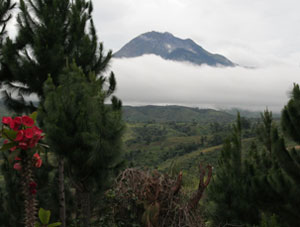Table of elevation extremes by geographic region
| Geographic region | Highest point | Maximum elevation | Lowest point | Minimum elevation | Elevation span |
|---|---|---|---|---|---|
| ⦁ Eurasia | Mount Everest, [1] China and Nepal | 8848 m 29,029 ft | Dead Sea, [2] Israel, Jordan, and Palestine | −428 m −1,404 ft | 9,276 m 30,433 ft |
| ⦁ Asia | Mount Everest, [1] China and Nepal | 8848 m 29,029 ft | Dead Sea, [2] Israel, Jordan, and Palestine | −428 m −1,404 ft | 9,276 m 30,433 ft |
| ⦁ Japanese Archipelago | Mount Fuji, Honshū, Japan | 3776 m 12,388 ft | Hachiro-gata, Honshū, Japan | −4 m −13 ft | 3780 m 12,402 ft |
| ⦁ Malay Archipelago | Gunung Kinabalu, Borneo, Malaysia | 4095 m 13,435 ft | South China Sea and Indian Ocean | sea level | 4095 m 13,435 ft |
| ⦁ Philippine Archipelago | Mount Apo, Mindanao, Philippines | 2954 m 9,692 ft | Philippine Sea and South China Sea | sea level | 2954 m 9,692 ft |
| ⦁ Sri Lanka | Pidurutalagala, Sri Lanka | 2524 m 8,281 ft | Indian Ocean | sea level | 2524 m 8,281 ft |
| ⦁ Europe | Mount Elbrus, Russia | 5642 m 18,510 ft | Caspian Sea, Russia, et al. | −28 m −92 ft | 5670 m 18,602 ft |
| ⦁ British Isles | Ben Nevis, Great Britain, Scotland, UK | 1343 m 4,406 ft | The Fens, Great Britain, England, UK | −4 m −13 ft | 1347 m 4,419 ft |
| ⦁ Africa | Kilimanjaro, Tanzania | 5892 m 19,331 ft | Lake Assal, [3] Djibouti | −155 m −509 ft | 6047 m 19,839 ft |
| ⦁ Madagascar | Maromokotro, Madagascar | 2876 m 9,436 ft | Indian Ocean | sea level | 2876 m 9,436 ft |
| ⦁ Americas | Aconcagua, Argentina | 6960 m 22,835 ft | Laguna del Carbón, Argentina | −105 m −344 ft | 7065 m 23,179 ft |
| ⦁ North America | Denali, Alaska, United States | 6190.5 m 20,310 ft | Badwater Basin, California, United States | −85.0 m −279 ft | 6275.5 m 20,589 ft |
| ⦁ Northern America | Denali, Alaska, United States | 6190.5 m 20,310 ft | Badwater Basin, California, United States | −85.0 m −279 ft | 6275.5 m 20,589 ft |
| ⦁ Greenland | Gunnbjørn Fjeld, Greenland | 3700 m 12,139 ft | Arctic Ocean and North Atlantic Ocean | sea level | 3700 m 12,139 ft |
| ⦁ Mesoamerica | Volcán Citlaltépetl (Pico de Orizaba) [a] | 5636 m 18,491 ft | Laguna Salada | −10 m −33 ft | 5646 m 18,524 ft |
| ⦁ Central America | Volcán Tajumulco, Guatemala | 4220 m 13,845 ft | North Pacific Ocean and Caribbean | sea level | 4220 m 13,845 ft |
| ⦁ Caribbean | Pico Duarte, Hispaniola, Dominican Republic | 3098 m 10,164 ft | Lago Enriquillo, Hispaniola, Dominican Republic | −45 m −148 ft | 3143 m 10,312 ft |
| ⦁ South America | Aconcagua, Argentina | 6960 m 22,835 ft | Laguna del Carbón, Argentina | −105 m −344 ft | 7065 m 23,179 ft |
| ⦁ Oceania | Puncak Jaya, Indonesia | 4884 m 16,024 ft | Lake Eyre, Australia | −15 m −49 ft | 4899 m 16,073 ft |
| ⦁ Australasia | Aoraki / Mount Cook, New Zealand | 3724 m 12,218 ft | Lake Eyre, Australia | −15 m −49 ft | 3739 m 12,267 ft |
| ⦁ Australia | Mount Kosciuszko, Australia | 2228 m 7,310 ft | Lake Eyre, Australia | −15 m −49 ft | 2243 m 7,359 ft |
| ⦁ Melanesia | Puncak Jaya, New Guinea, Indonesia | 4884 m 16,024 ft | Pacific Ocean | sea level | 4884 m 16,024 ft |
| ⦁ Micronesia | Mount Agrihan, Agrihan, Northern Mariana Islands | 965 m 3,166 ft | Pacific Ocean | sea level | 965 m 3,166 ft |
| ⦁ Polynesia | Mauna Kea, Hawaii, United States | 4207 m 13,802 ft | Taieri Plains, South Island, New Zealand | −2 m −7 ft | 4209 m 13,809 ft |
| ⦁ Antarctica | Mount Vinson, [4] Antarctica | 4892 m 16,050 ft | Southern Ocean | sea level | 4892 m 16,050 ft |
| | Mount Everest [1] | 8848 m 29,029 ft | Dead Sea [2] | −428 m −1,404 ft | 9,276 m 30,433 ft |






















